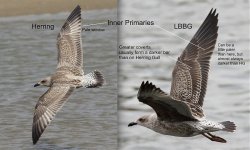Better than any book on the subject (and completely free) is the following website:
http://gull-research.org
What's good about it is that you can search for images of gulls month by month, and get multiple images to compare, so you get the full range of variation possible for each species (well almost-gulls are just so variable!)
Herring Gull is here:
http://www.gull-research.org/hg/0start.html
and Lesser Black-backed Gull here:
http://www.gull-research.org/lbbg1cy/0start.html
The best advice I can give is get as familiar with both species as you can. There will always be individuals that you struggle to identify, but you don't have to do every one-just aim to get a little more familiar (and hence more accurate in your IDs) each time.
It's hard to generalise about young gulls, but as you mentioned juveniles specifically, try to get good views (and photos if possible) of open wings and tail patterns. General structure is perhaps the best single feature, as it is fairly constant across all ages. LBBG is usually noticeably smaller (but there is overlap) and longer-winged, though as birds age through the various moult stages the primaries are gradually moulted out, with the result that older immatures can look shorter-winged than expected (until they re-grow).
Probably the best and most reliable plumage feature in juveniles, is that Herring Gulls have paler inner primaries than the other flight feathers (often called a 'window') whereas on LBBG the inner primaries are only slightly paler than the other flight feathers.
Make comparisons with your images and those in books or on the above website. You will soon start to tune into what to look for, and if you still need a second opinion then come back here! Good luck






